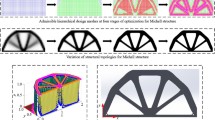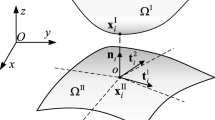Abstract
This work presents a truncated hierarchical B-spline–based topology optimization (THB-TO) to address topology optimization (TO) for both minimum compliance and compliant mechanism. The sensitivity and density filters with a lower bound are adaptively consistent with the hierarchical levels of active elements to remove the checkboard pattern and reduce the gray transition area. By means of the maximum variation of design variables on two consecutive iterative steps and the density differences of adjacent active elements, a mark strategy is established, which triggers the hierarchical local refinement and identifies the elements to be refined during the course of THB-TO. Besides, a locally refined design space is constructed in terms of the parent–child relationship of the cells on consecutive hierarchical levels. Numerical examples are used to verify the effectiveness of the proposed THB-TO, where the resolution around the boundary of the optimized designs can be effectively improved by THB-TO. Compared with global refinement, the number of degree of freedoms (DOFs) and design variables are largely decreased for 2D and 3D cases by THB-TO, which demonstrates that the proposed THB-TO is a promising approach to solving 2D and 3D TO problems.





























Similar content being viewed by others
References
Allaire G, Jouve F, Toader AM (2004) Structural optimization using sensitivity analysis and a level-set method. J Comput Phys 194(1):363–393
Andreassen E, Clausen A, Schevenels M, Lazarov BS, Sigmund O (2011) Efficient topology optimization in MATLAB using 88 lines of code. Struct Multidiscip Optim 43(1):1–16
Atri H, Shojaee S (2018) Meshfree truncated hierarchical refinement for isogeometric analysis. Comput Mech 62(6):1583–1597
Bendsøe MP (1989) Optimal shape design as a material distribution problem. Struct Optim 1(4):193–202
Bendsoe MP, Kikuchi N (1988) Generating optimal topologies in structural design using a homogenization method. Comput Methods Appl Mech Eng 71(2):197–224. https://doi.org/10.1016/0045-7825(88)90086-2
Boor CD (1972) On calculating with B-splines. J Approx Theory 6(1):50–62
Bruggi M, Verani M (2011) A fully adaptive topology optimization algorithm with goal-oriented error control. Comput Struct 89(15–16):1481–1493
Bruns TE, Tortorelli DA (2001) Topology optimization of non-linear elastic structures and compliant mechanisms. Comput Methods Appl Mech Eng 190(26–27):3443–3459
Buffa A, Giannelli C (2017) Adaptive isogeometric methods with hierarchical splines: optimality and convergence rates. Math Method Appl Sci 27(14):2781–2802
Carraturo M, Giannelli C, Reali A, Vázquez R (2019) Suitably graded THB-spline refinement and coarsening: towards an adaptive isogeometric analysis of additive manufacturing processes. Comput Methods Appl Mech Eng 348:660–679
Chau KN, Chau KN, Ngo T, Hackl K, Nguyen-Xuan H (2018) A polytree-based adaptive polygonal finite element method for multi-material topology optimization. Comput Methods Appl Mech Eng 332:712–739
Costa JCA Jr, Alves MK (2003) Layout optimization with h-adaptivity of structures. Int J Numer Methods Eng 58(1):83–102
de Troya MAS, Tortorelli DA (2018) Adaptive mesh refinement in stress-constrained topology optimization. Struct Multidiscip Optim 58(6):2369–2386
Gao J, Luo Z, Li H, Gao L (2019a) Topology optimization for multiscale design of porous composites with multi-domain microstructures. Comput Methods Appl Mech Eng 344:451–476
Gao J, Xue H, Gao L, Luo Z (2019b) Topology optimization for auxetic metamaterials based on isogeometric analysis. Comput Methods Appl Mech Eng 352:211–236
Garau EM, Vázquez R (2018) Algorithms for the implementation of adaptive isogeometric methods using hierarchical B-splines. Appl Numer Math 123:58–87
Giannelli C, JüTtler B, Speleers H (2012) THB-splines: the truncated basis for hierarchical splines. Comput Aided Geom D 29(7):485–498
Giannelli C, Jüttler B, Speleers H (2014) Strongly stable bases for adaptively refined multilevel spline spaces. Adv ComputMath 40(2):459–490
Guest JK, Prévost JH, Belytschko T (2004) Achieving minimum length scale in topology optimization using nodal design variables and projection functions. Int J Numer Methods Eng 61(2):238–254
Hennig P, Müller S, Kästner M (2016) Bézier extraction and adaptive refinement of truncated hierarchical NURBS. Comput Methods Appl Mech Eng 305:316–339
Hou W et al (2017) Explicit isogeometric topology optimization using moving morphable components. Comput Methods Appl Mech Eng 326:694–712
Huang X, Xie YM (2008) Optimal design of periodic structures using evolutionary topology optimization. Struct Multidiscip Optim 36(6):597–606
Hughes TJR, Cottrell JA, Bazilevs Y (2005) Isogeometric analysis: CAD, finite elements, NURBS, exact geometry and mesh refinement. Comput Methods Appl Mech Eng 194(39–41):4135–4195
Johannessen KA, Kvamsdal T, Dokken T (2014) Isogeometric analysis using LR B-splines. Comput Methods Appl Mech Eng 269:471–514
Kanduč T, Giannelli C, Pelosi F, Speleers H (2017) Adaptive isogeometric analysis with hierarchical box splines. Comput Methods Appl Mech Eng 316:817–838
KraftR (1997) Adaptive and linearly independent multilevel B-splines. SFB 404, Geschäftsstelle,
Kumar AV, Parthasarathy A (2011) Topology optimization using B-spline finite elements. Struct Multidiscip Optim 44(4):471–481. https://doi.org/10.1007/s00158-011-0650-y
Liao Z, Zhang Y, Wang Y, Li W (2019) A triple acceleration method for topology optimization. Struct Multidiscip Optim 60(2):727–744
Lieu QX, Lee J (2017) A multi-resolution approach for multi-material topology optimization based on isogeometric analysis. Comput Methods Appl Mech Eng 323:272–302
Lin C-Y, Chou J-N (1999) A two-stage approach for structural topology optimization. Adv Eng Softw 30(4):261–271
Liu K, Tovar A (2014) An efficient 3D topology optimization code written in Matlab. Struct Multidiscip Optim 50(6):1175–1196
Liu T, Li B, Wang S, Gao L (2014a) Eigenvalue topology optimization of structures using a parameterized level set method. Struct Multidiscip Optim 50(4):573–591
Liu T, Wang S, Li B, Gao L (2014b) A level-set-based topology and shape optimization method for continuum structure under geometric constraints. Struct Multidiscip Optim 50(2):253–273
Liu J, Li L, Ma Y (2017) Uniform thickness control without pre-specifying the length scale target under the level set topology optimization framework. Adv Eng Softw 115:204–216
Liu H, Yang D, Hao P, Zhu X (2018) Isogeometric analysis based topology optimization design with global stress constraint. Comput Methods Appl Mech Eng 342:625–652
Maute K, Allen M (2004) Conceptual design of aeroelastic structures by topology optimization. Struct Multidiscip Optim 27(1–2):27–42
Maute K, Ramm E (1995) Adaptive topology optimization. Struct Optim 10(2):100–112
Mei Y, Wang X (2004) A level set method for structural topology optimization and its applications. Comput Methods Appl Mech Eng 35(7):415–441
Nguyen-Xuan H (2017) A polytree-based adaptive polygonal finite element method for topology optimization. Int J Numer Methods Eng 110(10):972–1000
Norato J, Bell B, Tortorelli DA (2015) A geometry projection method for continuum-based topology optimization with discrete elements. Comput Methods Appl Mech Eng 293:306–327
Qian X (2010) Full analytical sensitivities in NURBS based isogeometric shape optimization. Comput Methods Appl Mech Eng 199(29):2059–2071
Qian X (2013) Topology optimization in B-spline space. Comput Methods Appl Mech Eng 265(3):15–35
Schillinger D, Dede L, Scott MA, Evans JA, Borden MJ, Rank E, Hughes TJ (2012) An isogeometric design-through-analysis methodology based on adaptive hierarchical refinement of NURBS, immersed boundary methods, and T-spline CAD surfaces. Comput Methods Appl Mech Eng 249:116–150
Scott MA, Li X, Sederberg TW, Hughes TJ (2012) Local refinement of analysis-suitable T-splines. Comput Methods Appl Mech Eng 213:206–222
Seo YD, Kim HJ, Youn SK (2010) Isogeometric topology optimization using trimmed spline surfaces. Comput Methods Appl Mech Eng 199(49–52):3270–3296
Sigmund O (2001) A 99 line topology optimization code written in Matlab. Struct Multidiscip Optim 21(2):120–127. https://doi.org/10.1007/s001580050176
Sigmund O, Maute K (2013) Topology optimization approaches. Struct Multidiscip Optim 48(6):1031–1055
Sigmund O, Petersson J (1998) Numerical instabilities in topology optimization: a survey on procedures dealing with checkerboards, mesh-dependencies and local minima. Struct Optim 16(1):68–75. https://doi.org/10.1007/bf01214002
Stainko R (2006) An adaptive multilevel approach to the minimal compliance problem in topology optimization. Commun Numer Meth En 22(2):109–118
Svanberg K (1987) The method of moving asymptotes—a new method for structural optimization. Int J Numer Methods Eng 24(2):359–373
Vuong A-V, Giannelli C, Jüttler B, Simeon B (2011) A hierarchical approach to adaptive local refinement in isogeometric analysis. Comput Methods Appl Mech Eng 200(49–52):3554–3567
Wang Y, Benson DJ (2016a) Geometrically constrained isogeometric parameterized level-set based topology optimization via trimmed elements. Front Mech Eng-Prc 11(4):1–16
Wang Y, Benson DJ (2016b) Isogeometric analysis for parameterized LSM-based structural topology optimization. Comput Mech 57(1):19–35. https://doi.org/10.1007/s00466-015-1219-1
Wang Z-P, Poh LH (2018) Optimal form and size characterization of planar isotropic petal-shaped auxetics with tunable effective properties using IGA. Compos Struct 201:486–502
Wang Y, Kang Z, He Q (2013) An adaptive refinement approach for topology optimization based on separated density field description. Comput Struct 117:10–22
Wang Y, Wang Q, Deng X, Xia Z, Yan J, Xu H (2015) Graphics processing unit (GPU) accelerated fast multipole BEM with level-skip M2L for 3D elasticity problems. Adv Eng Softw 82(2):105–118
Wang Y, Arabnejad S, Tanzer M, Pasini D (2018a) Hip implant design with three-dimensional porous architecture of optimized graded density. J Mech design 140(11):111406–111413. https://doi.org/10.1115/1.4041208
Wang Y, Wang Z, Xia Z, Poh LH (2018b) Structural design optimization using Isogeometric analysis: acomprehensive review. CMES-Comp Model Eng 117(3):455–507
Wang Z-P, Poh LH, Zhu Y, Dirrenberger J, Forest S (2019) Systematic design of tetra-petals auxetic structures with stiffness constraint. Mater Design 170:107669
Xia Q, Wang MY, Shi T (2015a) Topology optimization with pressure load through a level set method. Comput Methods Appl Mech Eng 283:177–195
Xia Z, Wang Q, Wang Y, Yu C (2015b) A CAD/CAE incorporate software framework using a unified representation architecture. Adv Eng Softw 87(C):68–85
Xia Z, Wang Y, Wang Q, Mei C (2017) GPU parallel strategy for parameterized LSM-based topology optimization using isogeometric analysis. Struct Multidiscip Optim 56(2):1–22
Xie YM, Steven GP (1993) A simple evolutionary procedure for structural optimization. Comput Struct 49(5):885–896
Xie X, Wang S, Xu M, Wang Y (2018) A new isogeometric topology optimization using moving morphable components based on r-functions and collocation schemes. Comput Methods Appl Mech Eng 339:61–90
Xie X, Wang S, Xu M, Jiang N, Wang Y (2019) A hierarchical spline based isogeometric topology optimization using moving morphable components. Comput Meth Appl Mech Eng 112696
Xu M, Wang S, Xie X (2019a) Level set-based isogeometric topology optimization for maximizing fundamental eigenfrequency. Front Mech Eng-Pract 14(2):222–234
Xu M, Xia L, Wang S, Liu L, Xie X (2019b) An isogeometric approach to topology optimization of spatially graded hierarchical structures. Compos Struct 225:111171
Zhang W, Yuan J, Zhang J, Guo X (2016) A new topology optimization approach based on moving Morphable components (MMC) and the ersatz material model. Struct Multidiscip Optim 53(6):1243–1260
Zhang W, Chen J, Zhu X, Zhou J, Xue D, Lei X, Guo X (2017a) Explicit three dimensional topology optimization via moving Morphable void (MMV) approach. Comput Methods Appl Mech Eng 322:590–614
Zhang W, Zhou Y, Zhu J (2017b) A comprehensive study of feature definitions with solids and voids for topology optimization. Comput Methods Appl Mech Eng 325:289–313
Zhou Y, Zhang W, Zhu J, Xu Z (2016) Feature-driven topology optimization method with signed distance function. Comput Methods Appl Mech Eng 310:1–32
Funding
This work has been supported by National Natural Science Foundation of China (No. 51675197, No. 51705158), the Fundamental Research Funds for the Central Universities (No. 2018MS45), and OpenFunds of National Engineering Research Centerof Near-Net-Shape Forming for Metallic Materials(No. 2018005).
Author information
Authors and Affiliations
Corresponding authors
Ethics declarations
Conflict of interest
The authors declare that they have no conflict of interest.
Replication of results
The proposed framework is built on the truncated hierarchical B-spline and classical SIMP method, the combination of which has been fully expounded in this work, so the results can be easily reproduced. Moreover, the opening the source code of the proposed method is banned by a project.
Additional information
Responsible Editor: Ji-Hong Zhu
Publisher’s note
Springer Nature remains neutral with regard to jurisdictional claims in published maps and institutional affiliations.
Rights and permissions
About this article
Cite this article
Xie, X., Wang, S., Wang, Y. et al. Truncated hierarchical B-spline–based topology optimization. Struct Multidisc Optim 62, 83–105 (2020). https://doi.org/10.1007/s00158-019-02476-4
Received:
Revised:
Accepted:
Published:
Issue Date:
DOI: https://doi.org/10.1007/s00158-019-02476-4




